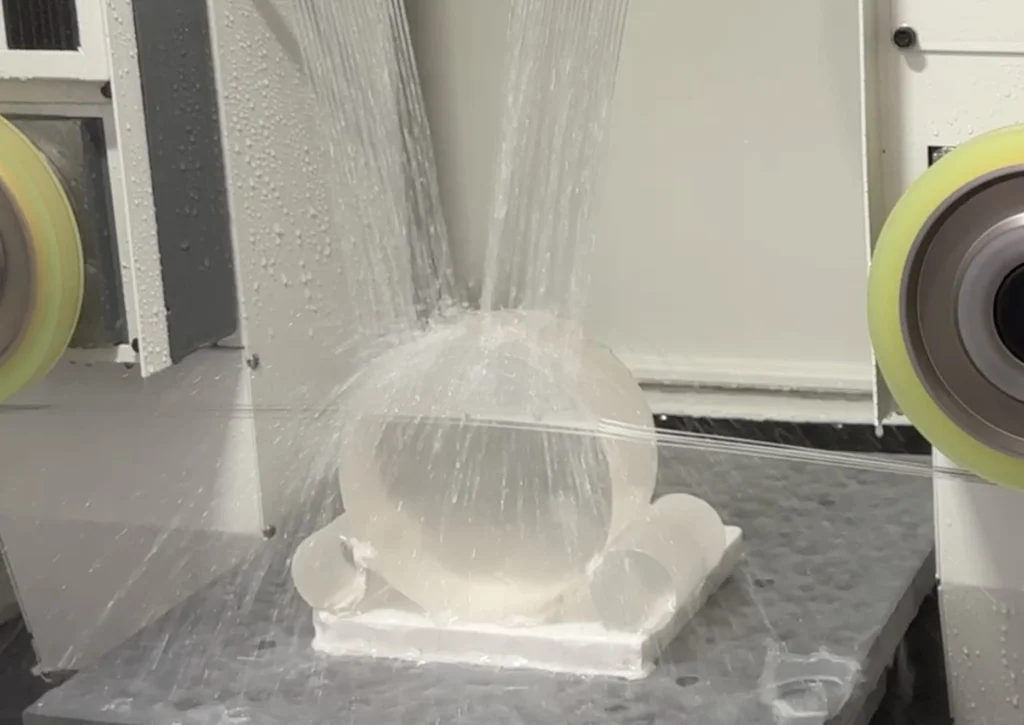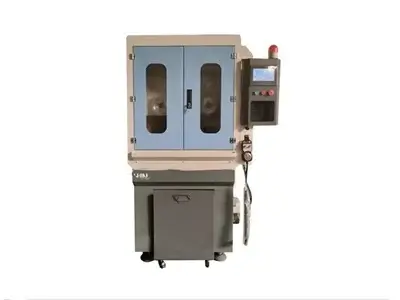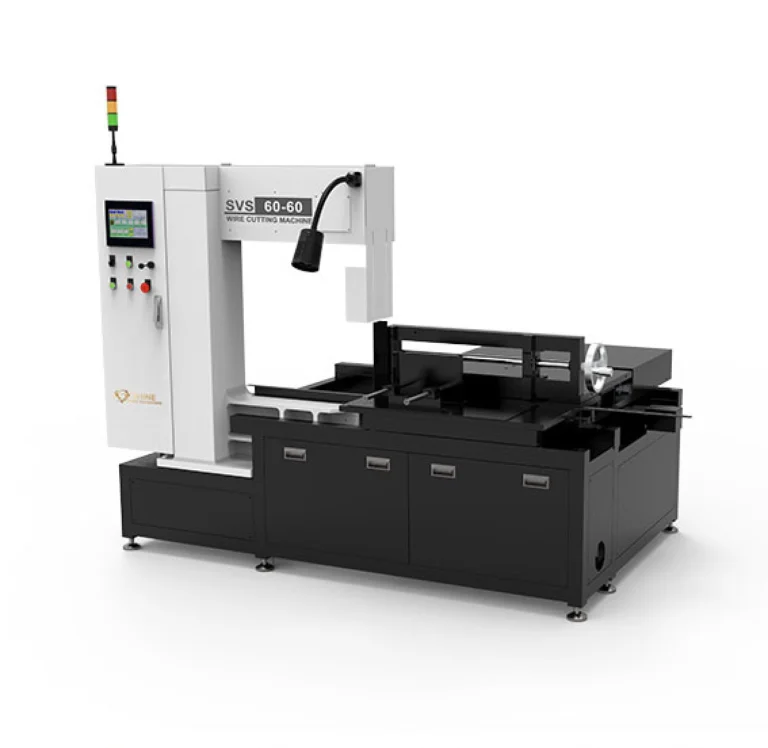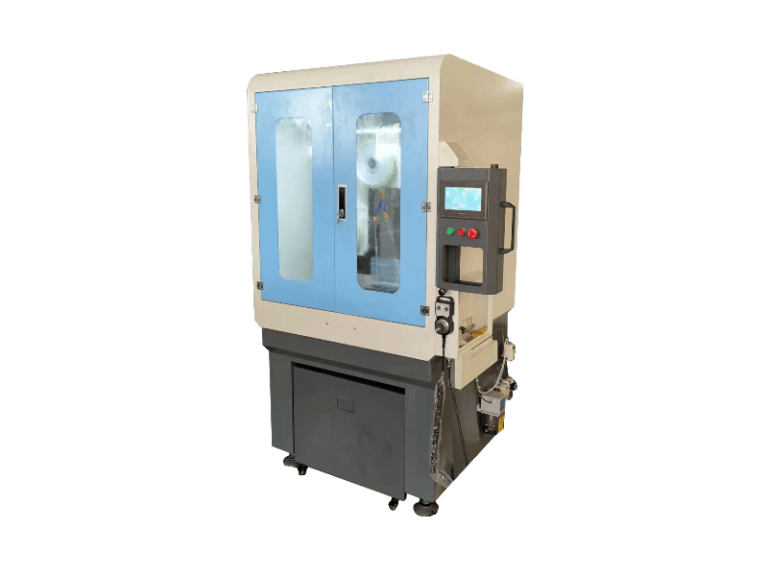
卓越した硬度と光学的透明性で知られるサファイアは、オプトエレクトロニクスから先端光学部品に至るまで、様々なハイテク産業において極めて重要な素材となっている。しかし、サファイアの精密切断は、その極めて高い硬度(モース硬度9、ダイヤモンドに次ぐ硬度)ともろさのために、ユニークな難題をもたらす。この記事では、サファイア切断の複雑さを探求し、当社の最近の切断実験の詳細を紹介することで、この困難な材料の加工における当社のエンドレスダイヤモンドワイヤーソーの能力を明らかにする。
サファイアのカッティングにおける課題
サファイアの硬度は、光学窓、レーザー部品、電子基板などの要求の厳しい用途に最適です。しかし、この同じ特性が、サファイアの切断を困難で時間のかかるプロセスにしています。従来の切断方法では、サファイアの硬度に苦戦することが多く、その結果、材料の無駄が増えたり、表面に傷がついたり、マイクロクラックが発生したりします。これらの課題を克服するには、ダイヤモンドワイヤーソーのような精密切断ツールが不可欠です。
サファイアの切断における主な困難の一つは、切断速度と表面品質のバランスを管理することである。速すぎる切断は過度の熱を発生させ、熱応力と潜在的なクラックの発生につながります。一方、切断速度が遅すぎると、仕上がり品質は向上するものの、時間とコストが増大するため、商業規模の生産には適さない場合があります。このため、適切な切断技術とパラメーターを選択することが、品質を維持しながら効率化を達成するための重要な要素となる。
伝統的なサファイアのカット方法
サファイアの伝統的なカット方法には次のようなものがある。 ダイヤモンドブレード丸鋸 そして ダイヤモンドワイヤーソー.サファイアの極端な硬度と脆さを扱う場合、それぞれの方法には限界がある:
- ダイヤモンドブレード丸鋸:これらの鋸は、回転するダイヤモンドコーティングブレードを使用してサファイアを切断します。粗い切断には効果的ですが、発生する摩擦が大きいため、しばしば大きな熱が蓄積され、熱応力が発生し、マイクロクラックのリスクが高まります。さらに、表面品質は一般的に劣り、さらなる研磨工程が必要となる。
- 従来のダイヤモンドワイヤーソー:従来のダイヤモンドワイヤーソーは、ダイヤモンドコーティングされた長いワイヤーを前後に動かして材料を切断します。この往復運動により、表面に目に見えるワイヤー跡が残ることがあり、追加の仕上げ加工が必要になります。さらに、往復運動により切断速度が制限されるため、最新の技術に比べ、加工に時間がかかります。
エンドレス・ダイヤモンド・ワイヤーソー:ゲームチェンジャー

私たちの エンドレスダイヤモンドワイヤーソー は、このような課題に取り組むために特別に設計されたもので、一方向に連続的に動くループ状のダイヤモンドワイヤーを利用することで、スムーズで均一な切断を実現します。方向を反転させる必要がある従来のダイヤモンドワイヤーとは異なり、エンドレスワイヤーは一貫した切断速度を維持するため、目に見えるワイヤーマークの発生を抑え、表面品質を向上させます。
その能力を実証するために、最近、我々は、カッティング実験を行った。 直径50mmのサファイア・ロッド.目標は、ロッドをスライスして 5.3mm厚ウェハー 精度を維持し、材料のロスを最小限に抑えながら。
実験の概要サファイアの切断結果
- 素材:直径50mmのサファイア・ロッド
- ターゲット:5.3mm厚ウェハー
- 切断時間:1切れあたり約30分
- 切断速度:当社のエンドレス・ダイヤモンド・ワイヤーは、次のような速度で作動した。 35 m/s 直線速度で精度と効率のバランスをとった。送り速度は 2mm/分.
- 我々が使用しているマシンモデル: SGR-40
この実験は望ましい結果を得ることに成功した。その 切断面は非常に滑らかだったワイヤーマークは見えず 寸法精度 のウェーハは許容範囲内に収まった。従来の方法と比較して、エンドレスダイヤモンドワイヤーソーは、効率と表面品質の両面で大きな利点をもたらしました。この結果は、次のような産業にとって特に重要である。 オプトエレクトロニクス表面のわずかな欠陥でさえ部品の性能に影響を与える可能性がある。
サファイアウェーハの用途
製造される5.3mm厚のサファイア・ウェーハは、さまざまな用途に最適である:

- オプティカル・ウィンドウズ:その優れた光学的透明性と耐熱性により、サファイアウェハーは高温用ビューポートやレーザーウィンドウによく使用されている。
- 半導体基板:サファイアは、半導体産業でよく使用される。 シリコン・オン・サファイア(SOS) RF機器の性能を向上させる技術である。
- オプトエレクトロニクス:サファイアは紫外から赤外までの波長にわたって透明であるため、LEDやその他のオプトエレクトロニクス部品として価値がある。
結論
サファイアの切断は困難ですが、適切な技術を用いれば、高品質の結果を効率的に得ることが可能です。エンドレス・ダイヤモンド・ワイヤーソーを使用した最近の切断実験は、切断技術の進歩がいかに厳しい素材の要求にも応えられるかを示しています。制御された切断速度を維持し、送り速度を最適化することで、無駄を最小限に抑えた精密な切断を実現し、生産効率の向上と製品品質の向上に貢献することができました。
産業界がサファイアのような高性能材料をますます求めるようになるにつれ、切断技術の革新はこれらの進歩を可能にする上で重要な役割を果たし続けるでしょう。当社のエンドレスダイヤモンドワイヤーソーは、このような技術革新の最前線に立ち、最も硬い素材にも信頼性の高い高精度切断ソリューションを提供します。







